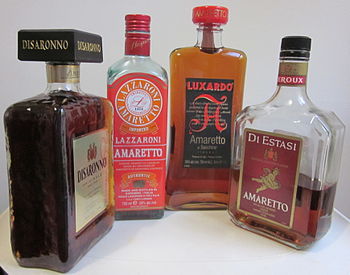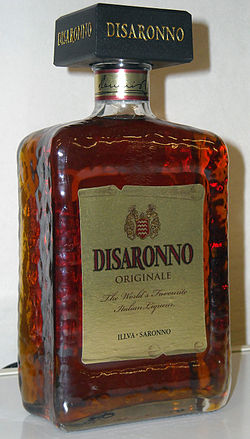Amaretto

Amaretto is a sweet, almond-flavoured, Italian liqueur. It is made from a base of apricot pits or almonds, sometimes both.[1]
Origin
Etymology
The name is a diminutive of the Italian amaro, meaning "bitter," indicating the distinctive flavour lent by the mandorla amara--the bitter almond or the drupe kernel. However, the bitterness is not unpalatable, and the flavour is enhanced by sweeteners, and sometimes sweet almonds, in the final products.[2] Therefore, the liqueur's name can be said to describe the taste as "a little bitter". Conflation of amaro and amore ("love") is primarily responsible for the associations with romance.[3] Amaretto should not be confused with amaro, a different family of Italian liqueurs that, while also sweetened, have a stronger bitter flavour from herbs.
Legend
Despite the known history on the introduction and acceptance of almonds into Italian cuisine, more recent takes on the meanings and origins have come about, further popularized by the two major brands. Though of sometimes questionable factuality, these tales hold a sentimental place in Saronno culture.
In 1525, a Saronno church commissioned artist Bernardino Luini, one of Leonardo da Vinci's pupils, to paint their sanctuary with frescoes.[4] As the church was dedicated to the Virgin Mary, Luini needed to depict the Madonna, but was in need of a model. He found his inspiration in a young widowed innkeeper, who became his model and (in most versions) lover. Out of gratitude and affection, the woman wished to give him a gift. Her simple means did not permit much, so she steeped apricot kernels in brandy and presented the resulting concoction to a touched Luini.[5][6]
Brands
Disaronno Originale

Disaronno Originale (28% abv) has a characteristic bittersweet almond taste (although it contains no almonds or nuts) and is known for its distinctive appearance. Disaronno has been in production since about 1900. It claims its "originale" amaretto's "secret formula" is unchanged from 1525,[7] and claims the Luini tale as its own particular history. Its production remains in Saronno, but the product is sold worldwide.
The company describes its amaretto as an infusion of "apricot kernel oil" with "absolute alcohol, burnt sugar, and the pure essence of seventeen selected herbs and fruits". The amber liqueur is presented in a rectangular glass decanter designed by a craftsman from Murano.
The product was originally named "Amaretto di Saronno Originale" (Original Amaretto from Saronno). It subsequently changed to "Amaretto Disaronno", transforming the origin of the product into a more distinctive brand name. Finally, it changed once more to "Disaronno Originale"; it has not marketed itself as an "amaretto" since 2001.
According to the Disaronno website, their amaretto contains no almonds, and is nut-free. Therefore, it is safe for people with nut or related allergies.
Lazzaroni Amaretto
Lazzaroni Amaretto (24% abv), produced by Paolo Lazzaroni & Figli S.p.A., also presents itself as the first such liqueur. It is based on an infusion of Amaretti di Saronno (macaroons), a process which imparts a "delicate almond/apricot flavour". Lazzaroni claim the tale of the young couple blessed by the bishop as the origin of their generations-guarded family recipe, dating it to 1718; the amaretto has been in production since 1851.[8]
Other brands
Many distillers produce their own brand of amaretto. Among them are Bols, DeKuyper, Hiram Walker, Luxardo, Paramount, and Phillips.
Usage
Amaretto serves a variety of culinary uses.
Cooking
- Amaretto is added to desserts, including ice cream, which enhances the flavour of the dessert with almonds and complements chocolate. Tiramisu, a popular Italian cake, is often flavoured with either real amaretto or alcohol-free amaretto aroma.
- Savoury recipes which call for it usually focus on meat, such as chicken.
- A few shots of amaretto can be added to pancake batter for a richer flavour.
- Amaretto is often added to almondine sauce for fish and vegetables.
- Amaretto is often added to whipped cream.
Beverages
Amaretto may be served neat (by itself) or on the rocks (with ice). It is often added to other beverages to create several popular mixed drinks. It is also a popular choice of liqueur to add to coffee in the morning.
The following cocktails highlight Amaretto liqueur as a primary ingredient.
- French Connection. Ingredients: Amaretto liqueur, Cognac and ice cubes
- Godfather. Ingredients: Amaretto liqueur, Scotch and ice cubes.
- Godmother. Ingredients: Amaretto liqueur, Vodka and ice cubes.
- Godchild. Ingredients: Amaretto liqueur, Cream and ice cubes.
- Toasted Almond. Ingredients: Amaretto liqueur, Kahlúa, Cream and ice cubes.
- Bocce Ball. Ingredients: Amaretto liqueur, Orange juice, Club soda and ice cubes.
- Cuban Breeze. Ingredients: Amaretto liqueur, Vodka, Pineapple juice and ice cubes.
- Lounge Lizard. Ingredients: Amaretto liqueur, Dark Rum, Cola and ice cubes. [1][2]
- Amaretto Sour. Ingredients: Amaretto liqueur, Sweet and Sour Mix.
See also
- Alcoholic Dr Pepper
- List of cocktails
Notes
- ^ "GOZIO Amaretto Almond Liqueur". AHardy USA Ltd. Retrieved October 18, 2010.
- ^ Hopkins, Kate. "Almonds: Who Really Cares?" (August 28, 2004). Accidental Hedonist. Retrieved January 1, 2007.
- ^ Harper, Douglas. "Amaretto". Online Etymology Dictionary. Retrieved 2007-01-01.
- ^ it.wikipedia.org: "Bernardino Luini". Retrieved January 1, 2007.
- ^ foodnetwork.ca. "A Brief History of Amaretto". Shaw Media Inc. Retrieved December 30, 2011.
- ^ Disaronno. Retrieved January 1, 2007. Home → Heritage → Page 2: The Legend. (A direct link is not available due to the Adobe Flash-based interface.)
- ^ Disaronno. Retrieved January 1, 2007. Home → Heritage → Page 4: The "Originale" Story. (A direct link is not available due to the Adobe Flash-based interface.)
- ^ Product description. Lazzaroni Amaretto. Heaven Hill Distilleries. Retrieved January 1, 2007.
